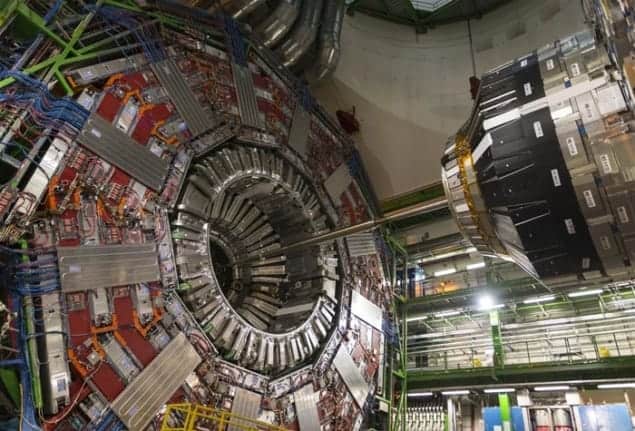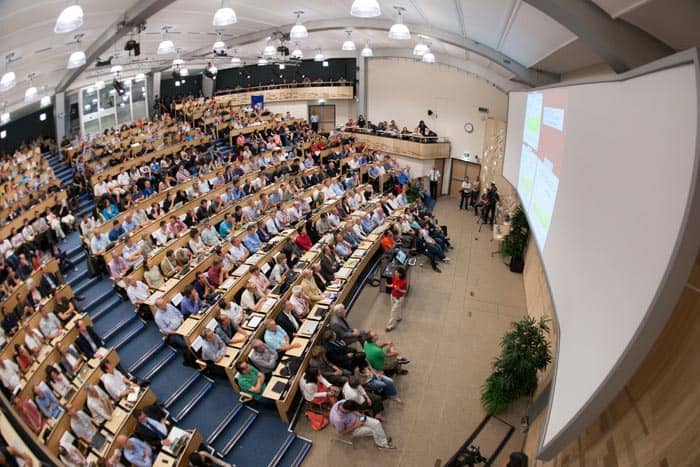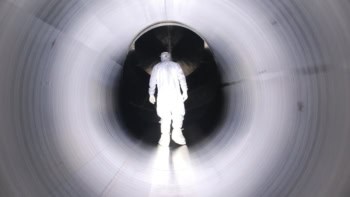
After discovering the Higgs boson last year, researchers at the Large Hadron Collider are now trawling through the data as the collider undergoes an 18-month shutdown for repairs and upgrades. The goal is to discover hints of physics beyond the Standard Model of particle physics – but tantalizing glimpses of new physics have been harder to spot than many physicists had expected.
Three years, eight-quadrillion particle collisions and the discovery of the most infamous particle of them all: the Higgs boson. With such achievements under their belt, you might think that physicists working on the Large Hadron Collider (LHC) at CERN, near Geneva, would be taking a well-earned break. But the current shutdown – a two-year period of repairs and upgrades that began in February – is affording them no holiday. “This is actually the most intense period we’ve ever had,” says Joseph Incandela, spokesperson for the LHC’s CMS experiment. “The schedule is so tight there’s almost no contingency to prepare for the next run. It’s a bit insane.”
Since starting up in October 2008 – and following a major malfunction a few weeks afterwards that took a year to fix – the LHC has rarely been out of the headlines. The focus of news has been on the search for the Higgs boson, the last piece in the Standard Model puzzle of elementary particles and forces. Strong hints of the Higgs’s existence came last July, when CERN announced the discovery of a new particle, the mass and production rate of which appeared close to Higgs parameters in Standard Model predictions. By March this year, other measured properties, such as zero spin and positive parity, had led the laboratory to claim that the new particle was a Higgs almost without any doubt.
Triumph and disappointment
But while the public has largely taken the discovery of the Higgs boson as mission accomplished for the €3.8bn collider, many particle physicists have been shaking their heads in disappointment. Since it started collecting data, the LHC has exposed few – if any – traces of physics beyond the Standard Model, a framework that is now some 40 years old. There has been no solid evidence for dark matter, supersymmetry, miniature black holes, extra dimensions or any of the other exotic phenomena that theorists excitedly talked about prior to the machine’s switch-on. If there is new physics still waiting to be found, the question is: where? And will it turn up in the current shutdown period from an analysis of existing data or in the next, higher energy run?
Those waiting for new physics can take comfort in the fact that the LHC has achieved far more than the discovery of the Higgs over its three-year operation. A year before the Higgs’s detection, for instance, the ATLAS experiment found another new boson: the so-called Chi-b(3P) quark-antiquark pair. That was followed by the discovery last year of a new excited Xi(b) baryon by CMS. Although not elementary particles like the Higgs is thought to be, Chi-b(3P) and Xi(b) have helped tie up some of the Standard Model’s loose ends by confirming the nature of the strong force, which binds quarks together.
Precision particle physics
Perhaps more important than these particle discoveries, however, have been the LHC’s precise measurements of existing Standard Model phenomena. Some of these are quantities that cannot be accurately predicted, such as the high-energy structure of the photon that is being studied by the ALICE experiment. But other measurements can put the latest theories to the test. These include the energy distribution of particle jets (which are produced when quarks collide), and the production rate of pairs of heavyweight elementary particles such as W and Z bosons (which carry the weak force, responsible for radioactive decay) and top quarks. “Those calculations have been taken now to a higher degree of precision,” says Incandela. “We have a very good match between our data and our simulations, which tells you that our calculations are very good.”

Testing the Standard Model in this way is not merely an excuse for self-congratulation; it allows theorists to figure out which of their more speculative hypotheses are worth pursuing. In 2008, for instance, the CDF and D0 experiments at the Tevatron collider at Fermilab in the US accumulated evidence for an unexpected asymmetry in the production of top- and antitop-quark pairs, such that more of the top quarks seemed to fly in the direction of the collider’s proton beam than ought to, given Standard Model predictions. Theorists rushed to explain the effect, invoking extra dimensions, supersymmetry and other new physics.
The problem was that the top quark was so heavy – more than 180 times as massive as the proton – that the Tevatron could not generate it in sufficient quantities to give reliable statistics. Conversely, the LHC, which collides protons at record-breaking energies of 7 TeV, has been able to generate millions of top-quark pairs. Although CERN’s collider has not been able to shed light directly on the Tevatron’s measured asymmetry, it has managed to show, via measurements of a related top-quark asymmetry at ATLAS, that most of those theories proposed to explain it must be wrong (arXiv:1203.4211).
Where are the sparticles?
Besides the discovery of the Higgs, then, one of the main achievements of the LHC to date has been in ruling out new-physics theories, or at least restricting the elbow room, or “parameter space”, in which they can operate. Top among all of these theories was always supersymmetry, the idea that every known elementary particle has one or more heavier partners, known as sparticles. Supersymmetry potentially offers a solution to the “hierarchy problem” – why the weak force is 1032 times stronger than gravity – and presents candidates for dark matter, the mysterious substance thought to make up 26.8% of the universe’s total mass–energy content. According to particle theorist Ben Allanach at the University of Cambridge in the UK, data taken at the LHC have excluded roughly half of supersymmetry’s parameter space.
If supersymmetry doesn’t crop up, I’ll then be getting pretty depressed
Ben Allanach, University of Cambridge
Much of the data from the LHC’s first run has not yet been analysed – the CMS collaboration, for instance, still has to comb through 40% of the 4.7 billion events it recorded last year. Allanach thinks there is a chance that hints of new physics, such as supersymmetry, will crop up in the data analysed during the shutdown period, but he thinks that any big discoveries will have to wait until 2015 when the accelerator restarts at the higher collision energy of 13 TeV. “My hopes are pinned on the next run,” he says. “The energy jump now is going to make the big difference. And if supersymmetry is the correct theory of nature, I would be expecting to see a big signal within the first month. If it doesn’t crop up, I’ll then be getting pretty depressed.”
Blind scanning
Others are not so optimistic. Last year, the Latvian theoretical physicist Mikhail Shifman posted an essay on the arXiv preprint server claiming that supersymmetry had failed its basic experimental tests, and that theorists should “stop blindly scanning the parameter space and start thinking and developing new ideas” (arXiv:1211.0004v1). But despite growing pessimism, there may already be signs of supersymmetry in current data. It may even arise out of the recently discovered Higgs boson. Its 125 GeV/c2 mass, combined with its production and decay rate, might fit well with Standard Model predictions, but it might also point to the lightest of several Higgs particles predicted to exist in the simplest versions of supersymmetry.
Null results are hard to sell to newspapers, but they are really important to scientific progress
Bill Murray, ATLAS
Bill Murray, deputy physics co-ordinator of the ATLAS collaboration – which, together with CMS, made the Higgs discovery – says that a supersymmetric Higgs would require a supersymmetric partner for the top quark, the “stop”, to be found at masses below 1000 GeV/c2. “That is a region we’re testing enthusiastically,” he says. But he stresses that he is open to the possibility of finding no evidence for supersymmetry. “Proving [supersymmetry] wrong would be as important as proving it right,” he says. “Null results are hard to sell to newspapers, but they are really important to scientific progress.”
A composite Higgs?
Many physicists have latched onto the Higgs discovery, hoping to find out whether it really does fit Standard Model predictions or whether, over the next few years, they will find hints of a more exotic nature. Even if the Higgs is not supersymmetric, there is the possibility that it is not elementary but a composite of smaller particles, or that its existence stretches over higher dimensions.
Theorist John Ellis of King’s College London is doubtful whether these more exotic possibilities will be correct, given, he says, that the Higgs’s properties are already known to agree with Standard Model predictions to within some 10% on average. But he thinks the next two years of shutdown could offer news on supersymmetry, as the rest of the first run’s data is analysed. “Experiments have looked under the most obvious lampposts for supersymmetric signatures,” he says. “Now, they’ve got two years during which all the graduate students can fan out and look under the many other possible lampposts. If we’re lucky, something might be lurking underneath one.”



